The 2002 Tour
| Heraklion | 35 20 19.37N 25 07 51.41E | You can clearly see the circuit of the walls that for so long defied the Turks. Our hotel was just to the west of the docks. |
| Rhodes | 36 26 44.78N 28 13 26.74E | The outline of the walls is impressive - but not half so impressive as seeing them on the ground! The coordinates give you the palace of the Grand Master. |
| Taksim Square | 41 02 11.25N 28 59 10.24E | The Marmara Hotel, Istanbul, which is where we usually stay. It has unrivalled views across the Bosphorus to Asia. |
| Anzac Cove | 40 12 46.02N 26 16 31.54E | There is little enough to be seen from the air and not much more on the ground, just the quiet beach and hills where thousands died. |
| Ephesus | 37 56 58.69N 27 21 50.32E | The coordinates are for the Temple of Artemis. You can see the shadow of the single pillar that remains standing (or has been re-erected). |
| Corinth | 37 54 18.77N 22 52 49.26E | The coordinates should give you the Bema, a stone platform jutting out into the agora, where St Paul stood trial. |
| Olympia | 37 38 15.68N 21 37 42.72E | The coordinates are for the workshop where the great statue of Zeus was made. The famous stadium can be clearly seen a short distance ENE. |
"I never thought I would stand here!" Olive exclaimed.
A couple of weeks before coming on our tour of Greece and Turkey, Olive had broken a bone in her foot, and although she was determined to go ahead with the journey, she expected that she would have to sit on the bus and watch the other tour group members seeing the places she had dreamed of exploring.
For her, the political situation in the Middle East was a blessing. With the usual tour of Egypt, Jordan and Israel cancelled, many people who had planned on doing both tours decided to postpone their trip until next year. The result was that we only had a small group, and as tour leader, I was able to devote more attention to each individual - and in Olive's case, that meant helping her climb slowly up the Acropolis while the compulsory guide led the rest of the group to the top.
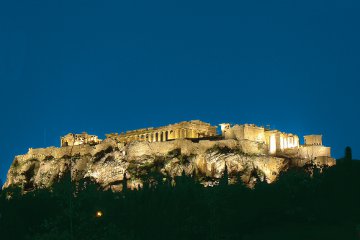
| |
| The Acropolis, the temple-fortress of Athens. |
Much of the Acropolis was a building site (as, indeed, is much of the surrounding area) as Athens prepared for the Olympic Games. Huge cranes towered over the Parthenon, carefully lifting blocks of ancient stone back into the positions from which they have been dislodged by time, accident and human endeavour. This meant that we could not walk into the temple of Athena, but we were able to look into the Erechtheum and other buildings on the summit.
Just below the start of the climb up to the Acropolis is a rocky knoll known as Mars Hill. In ancient times it was the place where the Areopagus council met, but today it is more famous as the place where St Paul preached the sermon recorded in Acts 17. Only a hundred yards or so away is the traditional Prison of Socrates, where the great philosopher is claimed to have been held after his condemnation for preaching strange doctrines. If the marble block, which is supposed to mark the exact spot where St Paul stood, is correct - highly unlikely, in my opinion - then he would have been facing the so-called prison as he spoke, which means that his sermon was not only a great piece of rhetoric, it was also an exhibition of courage.
At the foot of the Acropolis hill are the remains of the Agora. Excavations have revealed the start of the Sacred Way, which ran from Athens to Eleusis, as well as the foundations of many other buildings. One of these, a grand Stoa or covered colonnade, has been reconstructed, and tourists can stroll in the shade between the columns where once Athenians discussed the latest developments in philosophy or politics. In addition there is a museum on the ground floor and various offices and craft businesses upstairs.
At the far end of the Agora stands the Temple of Hephaestos, which has the most complete surviving roof of any ancient temple. Beyond it and across the railway line is the Keramikos, a large park in which excavations have uncovered more of the Sacred Way. The city wall of Athens, now in rather ruinous condition, runs across the site. Inside the wall are a number of buildings, including a public fountain; outside the wall was an extensive cemetery and the Keramikos museum is entirely devoted to finds made in it.
It is surprising how many Greeks were buried with their strigils - a curved metal implement used for scraping oil and sweat off an athlete's body. There is a large collection of splendid pottery and some remarkable tombstones, including one of a cavalryman, one of only five killed in a battle, and another of a woman and her grand-daughter, with a quite poignant inscription.
Although we have visited Greece on many occasions, this was the first time that we have run a tour to Greece. The only complaint that we received was that there was too much flying - though, to be strictly honest, no one minded the flying, with its views of dozens of islands set in the deep blue sea. It was all the waiting around at airports that quickly lost its novelty!

| |
| These tunnel-like buildings in Heraklion once sheltered and repaired Venetian galleys. |
The first of these flights came on the second day of the tour, when we headed for Crete and enjoyed a day of luxury at Heraklion, on the north coast. We visited the Heraklion museum with its collection of artefacts from Knossos, including the famous frescoes uncovered (and restored) by Sir Arthur Evans. Those who were energetic walked around the old city afterwards and admired its Venetian fortifications or shopped for curios.
The following morning we travelled out to Knossos, deliberately timing our journey so as to avoid the crowds off the three cruise ships that had docked during the night. The result was that we had an unhurried tour around the huge palace complex with its maze of rooms, corridors and stairways. There was still time, before our plane left, to visit Arhanes, a typical Cretan village, where a charming woman welcomed us to her family run cafe for some delicious food.
Olympic Airways seems to specialise in making life awkward for its customers. Not only did they cancel the flights we had booked from Australia, forcing us to make alternative and less convenient arrangements, but they have a flight from Crete to Rhodes every day of the week - except for Thursdays! This meant that we had to fly from Heraklion back to Athens and then from Athens to Rhodes - more waiting around in airports and an hour and a half in the air instead of forty minutes.

| |
| The palace of the Grand Master of the Knights of St John looks vastly impressive until you discover that it was built by Mussolini! |
However Rhodes was well worth the inconvenience. The old city, hidden behind its medieval walls, was a delight, with a network of tiny cobbled lanes opening onto tree-shaded squares lined with quaint old buildings. There were two things everyone wanted to see: the site of the Colossus of Rhodes, and the fortifications made famous by the Knights Hospitallers during their stubborn defence of the island against the forces of Sultan Suleiman the Magnificent.
The Colossus, long since gone, is supposed to have stood with its feet astride the harbour entrance, and two deer on pillars mark the traditional site of the statue. The Palace of the Grand Master of the Hospital was most impressive, with its sheer walls rising nearly 100' into the air. We had little difficulty in peopling its gloomy corridors with companies of knights, or filling the air with the screams of the wounded and the roar of Muslim canon.
An unexpected treat was a tour round the ancient city of Rhodes, on a hill overlooking the modern town. There we found a small but perfect Odeon, where anyone who stood in the exact centre of the half circle of seats would find his speech augmented by a fantastic echo effect, rather like singing in the bath. One cannot help but wonder whether the effect would have been so noticeable in a theatre filled with people.
Only a few tiers of seats remain around the nearby stadium, but at either end there is a curious arrangement of shallow trenches that are believed to have served a complicated starting mechanism. An official, standing in the end of one of the trenches, could release a string that caused a dozen gates to open simultaneously, thus ensuring that the start of each race was fair and square.
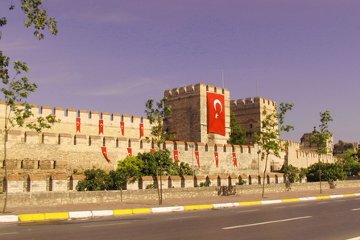
| |
| The mighty Theodosian Walls, which for so long kept the Turks out of Europe, bear the conqueror's stamp. |
After a free day in Athens we flew to Turkey and immediately plunged into an orgy of sightseeing. On the way from the airport to the hotel we stopped to climb up onto the massive Theodosian Land Walls of Byzantium, defences that withstood all invaders for nearly a thousand years. We then wound through the back streets of Istanbul to an insignificant gate in the walls. We had to walk through it and on the other side found a marble plaque, which I got Asli, our Turkish agent, to read in her mellifluous voice. It commemorates the entry of Mehmet the Conqueror into the city in 1453. Asli was astonished: even though she lives in Istanbul, she had no idea that this was the gate through which the great Muslim champion entered Byzantium!
It was our turn to be astonished a few minutes later when we came up the hill to Taksim Square and found the road to our hotel barred by police. A moment later we saw the reason why: squads of school children in smart uniforms marched past our stationary bus carrying flowers, flags and banners to place on a memorial at one end of the square. We had arrived on the day celebrated annually in commemoration of the capture of Constantinople by the Turks!
In the evening, as we returned from seeing Haghia Sophia and the Topkapi Palace, we were again held up by a procession of men in costume dragging three ships down the road from Taksim Square to the Golden Horn - a re-enactment of the expedient by which Mehmet the Conqueror gained control of this important waterway during his siege of Byzantium.
The terrorist attack on New York certainly cut the number of tourists and travellers in the Middle East that year and it was interesting to see the way in which the different countries reacted. Jordan, for example, cut the price of its premier attraction - Petra - by half, and reaped the reward in that more of those who visit Jordan now also visit Petra - and go away with pleasant memories of Jordanian hospitality.
Turkey, on the other hand, not only raised the price of admission to Haghia Sophia to a staggering 15,000,000 Turkish Lire, it also charged tourists an extra 15,000,000 for permission to climb up to the balcony (which is where the golden mosaics and other items of historic interest are to be found). Another charge is made for visitors to the Topkapi Palace, who now have to pay an extra fifteen million to visit the treasury, which last year was just another part of the palace.
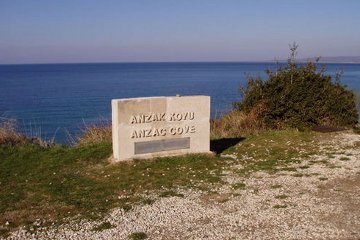
| |
| Anzac Cove is peaceful in the sunshine. "Johny Turk" deserves praise and thanks for the sensitive way the battlefield has been preserved. |
Once away from the capital, however, exhorbitant charges are not so evident. Several hours of travel in our air-conditioned bus brought us to Anzac Cove where we paid our respects at one of the many cemeteries which dot the rugged hills beside the sea. We crossed the famous Dardanelles in a ferry and then headed for Troy, where we wandered through ruins almost hidden by a profusion of deep red poppies. So many excavations have been conducted at Troy (and more are in progress) that it is a very confusing site to visit. A few steps take you from the Roman city to the pre-Greek era and back again, and it is easy to become confused over whether it is Troy VI or Troy VII - or, indeed, Troy IV - which saw the arms of Odysseus and the beauties of Helen.
Several more hours of travel, which took us past the sites of Troas and Assos, cities mentioned in the Book of Acts, and down the slopes of Mount Ida, brought us to Bergama, the ancient city of Pergamon. It was already late in the day, but we managed to explore the Asclepion, the much sought-after sanctuary of healing that John the Revelator referred to as "Satan's Seat", before eating a delicious Turkish meal in the pool-side restaurant of our hotel.
The following day we drove up to the summit of Pergamon's Acropolis, where we saw the remains of the famous library whose success the jealous Egyptians tried to cripple by banning the export of papyrus. Faced with the loss of the only practical paper known to the ancients, the ruler of Pergamon set his technicians to work and they came up with "pergamene" (later corrupted to "parchment") a writing material made from animal skin.
We saw the amazing theatre, cut into the side of a hill so steep that there was no room at the bottom for a permanent stage. For every performance slaves had to erect a prefabricated stage over the roadway leading to the temple of Dionysius - and the stone sockets in which the wooden beams were placed are still there. We saw the few surviving stones of the Altar of Zeus, erected as a thank offering for victory over the Gauls: the wonderful carvings from the altar are now in the Pergamon Museum in Berlin. We concluded our tour of Pergamon by a visit to the grave of Karl Humann, the German engineer who discovered the altar and smuggled the reliefs out of Turkey.
Three hours driving took us to Ephesus, one of the most striking ruined cities in the Middle East. We wandered down Curetes Street, photographed the Library of Celsus, tried out the acoustics in the theatre where once a mob spent two hours chanting "Great is Diana of the Ephesians" (Acts 19:28), and explored the ruins of the basilica where a council of bishops decreed that Mary should be regarded as the Theotokos - the God-bearer. (The theological point at issue was whether Mary gave birth to the physical part of Christ only or to the complete God-man - or, in other words, whether it was possible to separate the human and the divine in Jesus. The official answer is No.)
We paid a short visit to the extensive hole in the ground where Diana's great temple once stood. Deforestation and erosion not only buried the temple beneath six metres or more of mud, but also silted up the port on which Ephesus depended for its prosperity, with the result that the city died and now only exists to serve the tourists who flock to see the place where St Paul preached and St John lived.

| |
| The tomb of St John is believed to lie beneath this marble platform. |
Our final visit in Ephesus was to the grave of St John, which is in the ruins of a magnificent basilica on a hill overlooking the city. In a back room of the church there is a baptismal font where Christians of the time baptised by immersion - a fact I usually demonstrate by jumping down into the font. I didn't this time: there had been heavy rain two days before and the ancient font is still water-tight!
We said goodbye to our friendly bus driver and flew from Izmir to Ankara, the modern capital of Turkey, where we stayed in the splendid Ankara Hilton. Early the next morning another bus took us down to Cappadocia and the fantastic rock pinnacles of Goreme. On the way we passed a salt lake that is normally bright blue, but this time had a distinct pinkish tinge - possibly due to algae. A little further and the snow-capped Hasan Dagh came into view. Kate, one of the group members, had worked as an archaeologist in Turkey and Syria and knew that the ancient city of Catal Huyuk had grown rich on trade in the black obsidian found on the extinct volcano. To her delight, many of the souvenir stalls in the area sold razor-sharp sherds of obsidian!
The following day we drove north to Hattusas, the capital city of the ancient Hittites. The remains of the city are fascinating enough, but its dramatic mountain setting, surrounded by rugged gorges, is equally impressive. We explored the Great Temple of the Storm God, walked through the tunnel beneath the enormous artificial hill of the Sphinx Gate, clambered up to the Northern Palace - where I was able to show Kate some cisterns for which she had searched in vain on a previous visit.
We concluded our visit to Hittite country by exploring the temple of Yazilikaya, where the fissures in a rocky outcrop formed the open-air inner sanctum. The buildings that once stood in front of the rock are now nothing more than a line of foundation stones, but the carvings in the fissures are in remarkably good condition considering that they are some three thousand years old. Processions of gods and goddesses march across the rock face towards the giant figures of Tudhaliya IV, who stands in the protective embrace of the Hittite chief deity.
The only disappointment of the trip came the following day when we visited Gordion and the famous tomb mound of the rich King Midas. After several hours of travel, we were horrified to discover that restoration work had begun on the tomb that morning at eight o'clock. As a result the tomb was closed - and almost as annoying, the entrance to the Galatian tomb in the museum grounds was blocked by iron bars. Previously we have been able to clamber inside and see the intricate patterning of the corbelled roof, and though we can but applaud the measures taken to protect the tomb, they have certainly detracted from its interest.
To compensate in some measure for the disappointments, we took time to visit the tel of Gordion, a flat-topped mound that covers an extensive area of ground. Archaeological work there has uncovered a monumental gateway set in a massive wall, as well as the usual tangle of ruined buildings and plundered foundations, common to all ancient cities.
The tour was drawing to its close and after a free day in Istanbul, when some tour members visited the Grand Bazaar to shop for souvenirs, we flew back to Greece and drove from the airport down to Corinth. Our first stop on the way was at the vertical slit cut through the Isthmus of Corinth to link the Aegean and Adriatic Seas. The isthmus is only a couple of miles wide, but the voyage round the Pelopponese is several hundred miles and includes three capes notorious for their fickle weather and violent winds.
The earliest mariners avoided the perils of the voyage by unloading their goods on one side of the isthmus, carrying them across the neck of land, and loading them into another ship on the other side. Later on, the citizens of Corinth built the diolkos, a stone railway on which huge wooden frames transported fully-laden ships from one sea to the other. However this process was slow, and in any case was not open to the largest vessels, so a canal was the obvious answer. Despite fears that the Adriatic was higher than the Aegean, Nero began work on a canal, but the project died with him and it was not until modern times that the canal was dug using steam power instead of slaves.
The Acro-Corinth, a high mountain towering over the isthmus, was visible long before we arrived at Corinth. Our first stop was at the museum where our guide, observing our interest in the votive offerings made to the Asklepion, arranged for us to visit the museum storeroom where a much wider selection - including several life-size legs - was kept. These clay models, presented to the shrine by grateful patients, represented the afflicted part that had been healed. It is probable that many of the models were made of precious metals such as gold and silver, but they were long ago plundered and melted down. Only the less valuable ones of pottery or wood have survived.
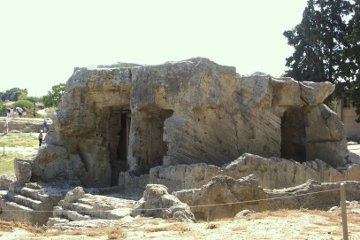
| |
| The fountain into which the unfortunate Glauke threw herself when given an inflammable wedding dress by Medea. It stands by the ticket office in Corinth. |
The ruins of Corinth are somewhat of a disappointment. Once one of the most important cities of Greece, notorious for the loose morals of its women, today it is represented by an area of ruins that is hardly larger than the average church yard. However, these ruins include the heart of the city - the agora, the bouleterion or council chamber, the bema or judgement seat before which St Paul was dragged by a hostile mob of Jews, and the Fountain of Peirene.
As well as its women, Corinth was also famous for its bronze, a particular alloy of metal that had a shiny black surface. Objects made of Corinthian Bronze were very expensive and much sought after in the ancient world. The Fountain of Peirene was in the centre of the bronze-workers' district and stone troughs into which the water ran have been identified as quenching basins, into which the bronzesmiths plunged the hot metal. Modern analysis has shown that various chemicals present in the water of Peirene were responsible for the colour of the bronze.
I have walked through streets of brass workers in India and been nearly deafened by the chink chink of a hundred hammers shaping the metal simultaneously. I have a lot of sympathy for St Paul who, doubtless with the Corinthian bronzesmiths in mind, declared, "Though I speak with the tongues of men and of angels, if I have not love I am nothing more than a sounding brass and a clanging cymbal." 1 Corinthians 13:1.
The day ended at Mycenae, the ancient Greek citadel that has given its name to a whole culture. Most visitors are surprised by the smallness of the place, which comprises a rocky peak surrounded by a massive wall in which is set the famous Lion Gate. The other surprise is the huge size of the circular precinct of the royal tombs where Schliemann found the gold masks now in the Athens museum.
Nearby are several tholoi or beehive tombs. A wide corridor cut into the rocky hillside leads to a doorway through which one steps into a large circular chamber. The chamber is covered by a corbelled roof; this means that each course of stones overlaps the one below it so that the roof looks like the inside of a cone soaring up into the gloom. Early explorers thought that such large structures must have a practical purpose and a particularly fine example was given the name "the Treasury of Atreus".
On the final day of the tour we travelled along the south coast of the Gulf of Corinth to Olympia, scene of the original games. The tiny modern village exists solely to serve the tourists who flock to the ancient ruins, and consists of a single long street lined by souvenir shops. Beyond them is a modern museum crammed with archaeological treasures: the remains of the reliefs that once crowned the temple of Olympian Zeus, tripods donated by tribes and individuals as thank-offerings, statues of gods and benefactors, and one shapeless lump of rock that, in my opinion, is as interesting as anything else in the museum.
Today there is a sneaking suspicion that many Olympic records owe as much to the chemical industry as they do to the power of the well-trained human body. Although the human propensity to cheat was just as strong in ancient times as it is today, hormones and steroids had not been invented back then, so the achievements of the ancients had to be genuine. Unfortunately, the ancient Greeks did not have stopwatches, so we cannot compare the winning times of modern and ancient runners, but there is one sport where we can compare like with like - weight lifting.
The lump of rock in question is about the size of a large sports bag and weighs 318 lbs. On it, in large letters, is an inscription stating that a certain Theon lifted it above his head - with one hand! The male members of the group weighed up the stone with our eyes and concluded that Theon, whoever he was, was stronger by far than we are today.
>From the museum we crossed the road to the ruins of the complex of temples that surrounded the stadium where the athletics took place. It is important to realise that for the ancient Greeks, the Olympic Games were not about running faster and setting new records. For them a games was a religious occasion. Xenophon, describing the thankfulness of his ten thousand mercenaries on arriving at the sea, says that they promptly organised a games in honour of the gods.
Thus to the Greeks, the temples were at least as important as the stadium. Certainly the statue of Zeus erected at Olympia was one of the most magnificent ever created - it ranked as one of the wonders of the world. We were, therefore, interested to see the ruins of the workshop in which this wonderful image was carved and cast. (The museum contains some of the moulds in which the bronze work of the image was cast.)
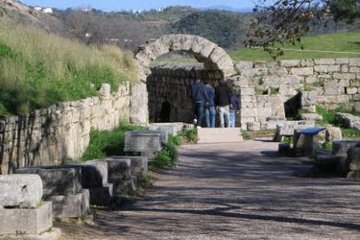
| |
| On the left are the bases for the statues erected by cheats! |
Because of the religious nature of the site and the event, winners were not usually commemorated by statues at Olympia. Instead they dedicated a tripod - a bowl standing on three legs - to the gods, and went home to where statues were usually erected in their honour. The only competitors immortalised - if that is the word I want - by a row of statues were those caught cheating. They had to pay for a statue of themselves, complete with their names and cities of origin, erected outside the entrance to the stadium, where both spectators and competitors could see their ignominy. Unfortunately, though the bases are intact, none of the statues has survived, so we don't know whether they were misshapen in some way, or otherwise disfigured to add to the disgrace.
The stadium is like every other stadium in the ancient world: a long flat area, rounded at one end and with banks of seats on every side. The starting block has been preserved, a row of stone blocks set into the ground, in which were carved two parallel grooves. Athletes could hook their toes into the grooves, thus giving themselves the purchase necessary for an explosive start down the track - which was, curiously enough, exactly one stadium long. (In other words, the length of the Olympic stadium became a measure of distance, used much as we might use the word "mile" to denote how far it was from A to B. We might say "ten miles", the ancient Greek said "ten stadiums" - or, to be strictly pedantic, "ten stadia".)
This was the last site we were to visit, so once the place had been thoroughly explored we descended on the street of souvenir shops to purchase T-shirts for all those friends and relatives who had not yet had gifts bought for them. Greece had one more surprise for us, however. The traffic in Athens is notoriously bad and the fumes from stationary cars, trucks and buses are blamed for much of the deterioration of the ancient buildings on the Acropolis. With this in mind, the guide and I persuaded the group that we needed to make an early start the next morning so as to be sure of getting to the airport on time. Much to my surprise and the disgust of those who had had their fill of departure lounges, we sailed through Athens and reached the airport nearly an hour earlier than we needed to.
My flight to Britain left two hours after everyone else departed for home, and wandering round the airport for the umpteenth time, I came across a Greek newspaper which someone had abandoned and which solved the mystery of the lack of traffic. Sixteen thousand taxi drivers had gone on strike that day, so there were sixteen thousand fewer cars clogging up the streets!





